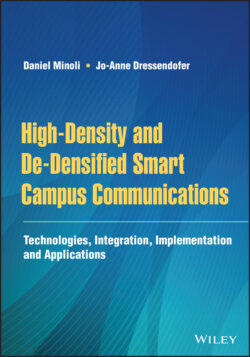Читать книгу High-Density and De-Densified Smart Campus Communications - Daniel Minoli - Страница 28
1.4 THE CONCEPT OF A WIRELESS SuperNetwork
ОглавлениеInstitutional (corporate/campus) networks (INETs) have evolved considerably in the past 60 years, which spans the era of data communications. Figure 1.10 depicts a view of this evolution. As the decade of the 2020s dawned, one can assert that we have reached a stage where “super‐integrated,” feature‐rich INETs have emerged (what might be labeled as INET‐v6). Such “super integration” in the corporate/campus now covers (i) voice services in the form of VoIP, VoWi‐Fi, DASs, and private (virtual) cellular networks (in addition to the public cellular networks edging toward 5G); (ii) extreme reliance of Wi‐Fi access in the form of Wi‐Fi 6 and also new usable bands; (iii) Virtual Private Networks as the wide‐area connectivity of choice; (iv) integration of Building Management Systems (BMS) to support smart building/smart campus functionality along with RTLS and more general IoT functionality; (v) cloud‐based services and analytics, also based on the concepts of Software Defined Networks (SDNs) and Network Function Virtualization (NFV); (vi) massive use of videoconferencing as well as (corporate reception where/as needed) of OTT/IPTV video feeds (e.g. business TV); and the widespread use of Artificial Intelligence (AI), Machine Learning (ML), and Deep Learning (DL).
FIGURE 1.9 De‐densified (heuristic model).
Herewith we introduce the concept of a Wireless SuperNetwork (WiSNET)TM. A super‐integrated service‐rich INET network where the preponderance of the local and edge connectivity is wireless; such a WiSNET, in addition to the underlying technologies just cited, enjoys, in fact, requires a unified, highly flexible, cost‐effective management and administration apparatus. The SuperNetwork embodies a unified, comprehensive, scalable architecture for high‐density, high‐throughput multimedia communications, supporting open, scalable, and inexpensive technology for secure, QoS‐enabled, high‐mobility services for a plethora of users having a variety of connectivity and access requirements that span multiple use cases.
This SuperNetwork concept is elaborated at some length in Chapter 10.
The rest of the text will discuss many (but not all) of the constituent technologies that support the realization of such WiSNETs.
TABLE 1.10 HDC KPIs for Airports
| Key Performance Indicators | Key Performance Indicators | Pre‐pandemic Requirements | Post‐pandemic Requirements |
|---|---|---|---|
| Data/VoIP connection density, for people on smartphones, laptops, tablets | Data/VoIP connection density, for people on smartphones, laptops, tablets | 1 per 20 ft2 in terminals | 1 per 80 ft2 in terminals |
| User experienced data rate | 10–50 Mbps | Same | |
| Peak data rate | 100 Mbps | Same | |
| Traffic volume density | 5 Gbps per gate area (200 people per gate) | 1.25 Gbps per gate area (50 people per gate) | |
| End‐to‐end latency | 100 ms | Same | |
| Wayfinding | Throughout airport and in adjacent spaces | Same | |
| Area of coverage | Entire airport and in adjacent spaces, garages, car rental locations | Same | |
| Traditional telephony on DAS systems | Dialtone | 50 Erlangs per gate area (200 people per gate) | 12 Erlangs per gate area (50 people per gate) |
| Call length | 10 minutes per call | Same | |
| Connection density, IoT devices | Connection density, IoT devices | 1 per 10 ft2 throughout airport | Same |
| User experienced data rate | 0.384 Mbps | Same | |
| Peak data rate | 0.768 Mbps | Same | |
| Traffic volume density | 100 Mbps per 1000 ft2 throughout airport and in adjacent spaces, garages, car rental locations | Same | |
| End‐to‐end latency | 1–10 ms | Same | |
| Area of coverage | Entire airport and in adjacent spaces | Same |
